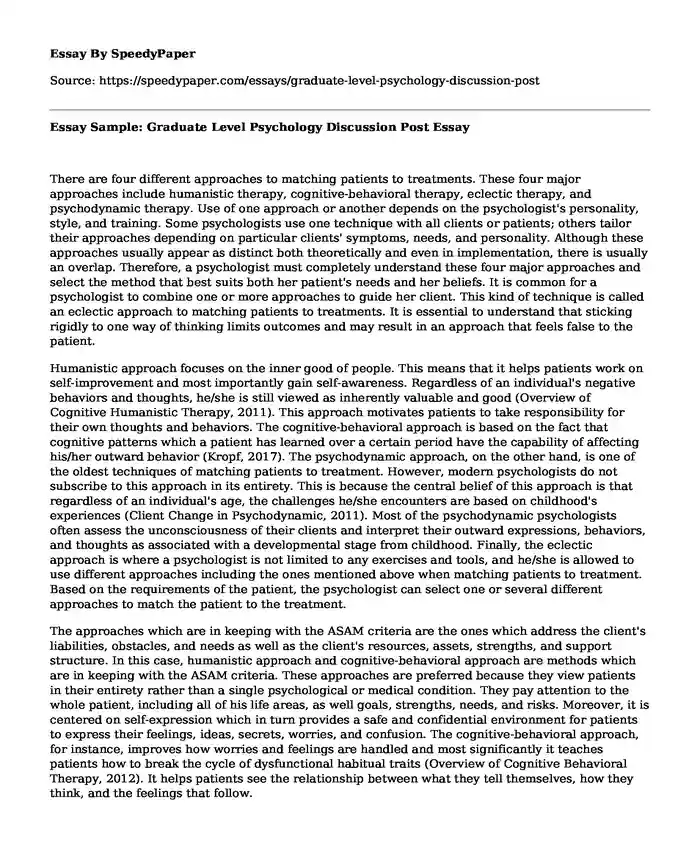
| Type of paper: | Essay |
| Categories: | Psychology Counseling |
| Pages: | 3 |
| Wordcount: | 676 words |
There are four different approaches to matching patients to treatments. These four major approaches include humanistic therapy, cognitive-behavioral therapy, eclectic therapy, and psychodynamic therapy. Use of one approach or another depends on the psychologist's personality, style, and training. Some psychologists use one technique with all clients or patients; others tailor their approaches depending on particular clients' symptoms, needs, and personality. Although these approaches usually appear as distinct both theoretically and even in implementation, there is usually an overlap. Therefore, a psychologist must completely understand these four major approaches and select the method that best suits both her patient's needs and her beliefs. It is common for a psychologist to combine one or more approaches to guide her client. This kind of technique is called an eclectic approach to matching patients to treatments. It is essential to understand that sticking rigidly to one way of thinking limits outcomes and may result in an approach that feels false to the patient.
Humanistic approach focuses on the inner good of people. This means that it helps patients work on self-improvement and most importantly gain self-awareness. Regardless of an individual's negative behaviors and thoughts, he/she is still viewed as inherently valuable and good (Overview of Cognitive Humanistic Therapy, 2011). This approach motivates patients to take responsibility for their own thoughts and behaviors. The cognitive-behavioral approach is based on the fact that cognitive patterns which a patient has learned over a certain period have the capability of affecting his/her outward behavior (Kropf, 2017). The psychodynamic approach, on the other hand, is one of the oldest techniques of matching patients to treatment. However, modern psychologists do not subscribe to this approach in its entirety. This is because the central belief of this approach is that regardless of an individual's age, the challenges he/she encounters are based on childhood's experiences (Client Change in Psychodynamic, 2011). Most of the psychodynamic psychologists often assess the unconsciousness of their clients and interpret their outward expressions, behaviors, and thoughts as associated with a developmental stage from childhood. Finally, the eclectic approach is where a psychologist is not limited to any exercises and tools, and he/she is allowed to use different approaches including the ones mentioned above when matching patients to treatment. Based on the requirements of the patient, the psychologist can select one or several different approaches to match the patient to the treatment.
The approaches which are in keeping with the ASAM criteria are the ones which address the client's liabilities, obstacles, and needs as well as the client's resources, assets, strengths, and support structure. In this case, humanistic approach and cognitive-behavioral approach are methods which are in keeping with the ASAM criteria. These approaches are preferred because they view patients in their entirety rather than a single psychological or medical condition. They pay attention to the whole patient, including all of his life areas, as well goals, strengths, needs, and risks. Moreover, it is centered on self-expression which in turn provides a safe and confidential environment for patients to express their feelings, ideas, secrets, worries, and confusion. The cognitive-behavioral approach, for instance, improves how worries and feelings are handled and most significantly it teaches patients how to break the cycle of dysfunctional habitual traits (Overview of Cognitive Behavioral Therapy, 2012). It helps patients see the relationship between what they tell themselves, how they think, and the feelings that follow.
One of the key shortcomings of the methods that are not in keeping with the ASAM criteria is that psychologists cannot use multidimensional assessment. Instead, psychologists are forced to focus on an isolated symptom or a diagnosis. Therefore, this may result in an approach that feels false to the patient.
References
Client Change in Psychodynamic-Interpersonal Therapy. (2011). Psychodynamic-Interpersonal Therapy: A Conversational Model,33-50. doi:10.4135/9781526401830.n3
Kropf, N. P., & Cummings, S. M. (2017). Cognitive Behavioral Therapy. Oxford Scholarship Online. doi:10.1093/acprof:oso/9780190214623.003.0004
Overview of Cognitive Behavioral Therapy. (2012). Cognitive Behavioral Therapy for Chronic Illness and Disability,15-21. doi:10.1007/0-387-25310-6_2
Overview of Cognitive Humanistic Therapy. (2011). Cognitive Humanistic Therapy: Buddhism, Christianity and Being Fully Human,77-87. doi:10.4135/9781446211489.n6
Cite this page
Essay Sample: Graduate Level Psychology Discussion Post. (2022, Mar 18). Retrieved from https://speedypaper.net/essays/graduate-level-psychology-discussion-post
Request Removal
If you are the original author of this essay and no longer wish to have it published on the SpeedyPaper website, please click below to request its removal:
- Look for Professional Mission Statement of a Teacher in our Free Essay
- Free Essay on Community-oriented Policing
- Importance of NCAA - Free Essay Example
- Essay Sample: Mozart's Creative in Soundtrack for the Amadeus Movie
- Free Essay with the Mock Clinical Interview Example
- How GI Health Can Impact Overall Health? - Essay Sample
- Essay Sample on Corporate Governance in Sports Direct
Popular categories




